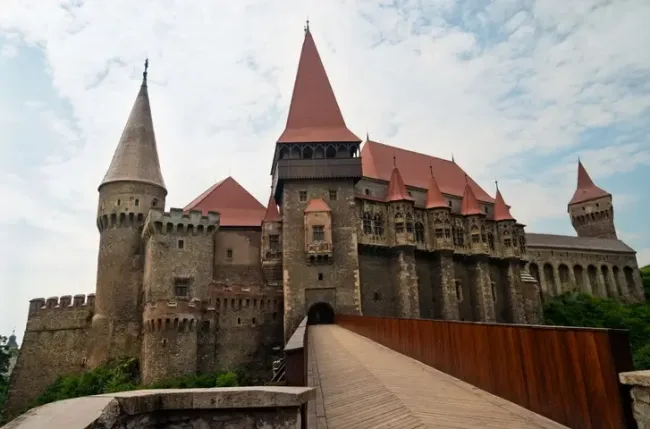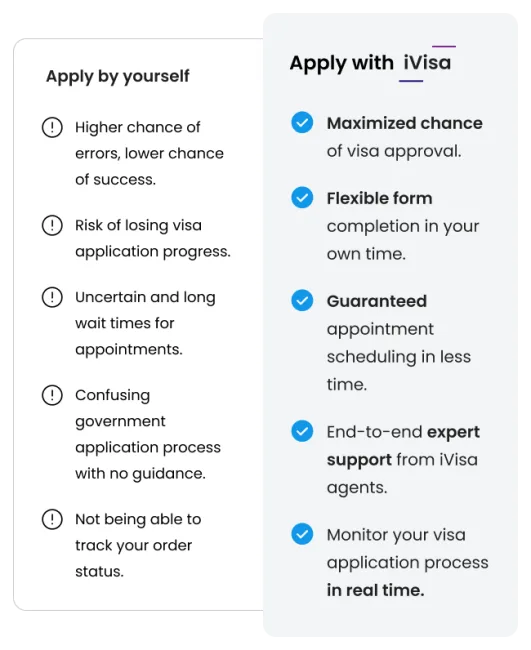Romania ETIAS Travel Authorization: Join the waitlist
Last updated: September 2023
There's a new travel update for non-EU visitors from visa-exempt countries who want to visit Romania in 2024.
Fancy wandering through Bucharest's vibrant Lipscani district or feeling the mystery of Bran Castle? Here's a heads-up: The days of just hopping on a plane with visa-free privileges are changing. Travelers from visa-exempt nations outside the European Union will now require an ETIAS travel authorization to journey through Romania and its fellow Schengen member states.
Let's break down the Romania ETIAS. We’ll guide you through the application process, share who's eligible, and discuss the costs involved.

What is the Romania ETIAS?
In 2016, the idea of the ETIAS was introduced to strengthen the security framework of Europe and the Schengen Area. Historically, visitors from certain countries only needed to present a valid travel document, such as a passport, to gain entry to this zone. This left European authorities with minimal information about visa-free travelers, posing potential risks.
To address this gap, the European Travel Information and Authorisation System, commonly referred to as ETIAS, was conceptualized. Launching in 2024, this electronic travel authorization will serve those who, in earlier times, could journey across Europe without a visa. It promises a broader and more meticulous oversight of travelers, thereby enhancing the security dynamics.
As part of the Schengen Zone, Romania has embraced this change. Consequently, visa-exempt travelers eager to explore Romania's rich history and culture will need to secure a Romania ETIAS authorization before setting foot in the country.
Apply now for the Romania ETIAS with us!
What can I do in Romania with an ETIAS travel authorization?
With an ETIAS authorization, you have the green light to visit Romania and the entire Schengen Area for various purposes, including:
-
Leisure and tourism
-
Engaging in business tasks, such as attending meetings or conferences
-
Undertaking short-term studies for up to 3 months
-
Seeking medical attention
What can I not do with the Romania ETIAS?
There are specific activities the Romania ETIAS doesn't cover. You cannot:
-
Engage in academic programs extending beyond 3 months
-
Seek employment
-
Establish long-term or permanent residency in Romania
Who can apply for the Romania ETIAS?
The Romania ETIAS caters to individuals from countries that have the privilege of visa-free access to Europe and the Schengen region.
These European nations require that visa-exempt visitors possess an ETIAS travel authorization:
| Austria | Germany | Netherlands |
|---|---|---|
| Belgium | Greece | Norway |
| Bulgaria | Hungary | Poland |
| Croatia | Iceland | Portugal |
| Cyprus | Italy | Romania |
| Czech Republic | Latvia | Slovakia |
| Denmark | Liechtenstein | Slovenia |
| Estonia | Lithuania | Spain |
| Finland | Luxembourg | Sweden |
| France | Malta | Switzerland |
For a successful application of an ETIAS authorization, you must meet these conditions:
-
You must not be an EU national
-
Your home country must have a visa exemption agreement for brief stays with European states that require the ETIAS
-
You must not have been granted a residency permit or card by an EU country
Who is eligible for the Romania ETIAS?
Individuals from non-EU countries that currently enjoy visa-free entry into Europe, including Romania and the broader Schengen Area, must secure an ETIAS to visit this country in 2024.
| The following nations qualify for the ETIAS travel authorization: | Albania | Hong Kong | Saint Kitts and Nevis |
|---|---|---|---|
| Antigua and Barbuda | Israel | Saint Lucia | |
| Argentina | Japan | Saint Vincent | |
| Australia | Kiribati | Samoa | |
| Bahamas | Macau | Serbia | |
| Barbados | Macedonia | Seychelles | |
| Bosnia and Herzegovina | Malaysia | Singapore | |
| Brazil | Marshall Islands | Solomon Islands | |
| Brunei | Mauritius | South Korea | |
| Canada | Mexico | Taiwan | |
| Chile | Micronesia | Timor Leste | |
| Colombia | Moldova | Tonga | |
| Costa Rica | Montenegro | Trinidad and Tobago | |
| Dominica | New Zealand | Tuvalu | |
| El Salvador | Nicaragua | Ukraine | |
| Georgia | Palau | United Arab Emirates | |
| Grenada | Panama | United Kingdom | |
| Guatemala | Paraguay | United States of America | |
| Honduras | Peru | Uruguay | |
| Vanuatu | |||
| Venezuela |
ETIAS-exempt: Who doesn't need to apply for a Romania ETIAS?
Residents and citizens of the EU aren't required to obtain a Romania ETIAS. By simply using their passport or national ID card, they can move unrestrictedly within Romania and the entire Schengen Area.
For those holding a valid Schengen visa, there's no need to secure a Romania ETIAS either.
Can minors apply for a Romania ETIAS?
Minors who are from countries exempted from visas are required to possess a Romania ETIAS visa waiver before their arrival in the country.
The child's parent or a legal guardian should fill out and submit the ETIAS application on their behalf. When it comes to multiple minors, remember that individual applications are necessary for each one.
How long can I stay in Romania with the ETIAS?
The ETIAS remains valid for a span of 3 years. If the travel document used during the ETIAS application expires sooner than that, you will need to apply for a new one.
Visitors possessing an ETIAS can travel between Romania and other Schengen countries multiple times. However, bear in mind that cumulative stays shouldn't go beyond 90 days within a half-year window.
Can I extend my Romania ETIAS?
Extensions aren't an option for the Romania ETIAS after its expiration. A fresh application is mandatory.
Also, as mentioned, in situations where your travel document expires while the ETIAS is still active, a new ETIAS application is necessary.
Required documents for the Romania ETIAS
To apply for an ETIAS, you will need:
-
A valid travel document – Usually, this is a passport that should remain valid for at least three more months after your planned exit date from the Schengen Zone.
-
Filled-out application form – Be ready to share details like your birth date, nationality, your parents' names, educational background, current job, initial country of stay, and destination address. Information on any prior criminal records or trips to conflict zones might also be necessary.
In cases where you have relatives in any European country requiring ETIAS clearance, it's imperative to share their personal details. Clarifying your relationship with them is also a must.

How to apply online for the ETIAS Romania
When the ETIAS system rolls out, securing one via our platform will be an easy endeavor. Here's how to do it:
-
Step 1 - Provide your basic information and travel details on our website or the easy-to-use iVisa app. Choose your preferred processing time and pay the fees.
-
Step 2 - Fill out the ETIAS application form and upload the required documents.
-
Step 3 - Submit the form and wait for an email confirming the submission of your application, which will include your unique ETIAS application number.
When your ETIAS is approved, ensure you make a printed copy and keep a digital copy on your phone. This will make for an easier time at any airport check and Schengen entry point.
Benefits of getting your Romania ETIAS with us
Choosing our service ensures a stress-free journey in securing your Romania ETIAS. Here are the key reasons to go with our platform:

Romania ETIAS fees and cost
The official government fee for the Romania ETIAS is 7 euros (approximately $8).
No fees are required for travelers below 18 years of age and those above 70.
To enhance your application experience, we highly recommend using iVisa and our team of experts. Bear in mind that this convenience comes at an additional cost.
Romania ETIAS processing time
While most applicants secure their ETIAS authorization in minutes, there can be instances where it takes up to 30 days. Therefore, we recommend applying well in advance of your intended travel date.
Once the ETIAS is in action, our website offers a straightforward application process with three distinct timelines:
-
Standard processing time: Ideal if you have some time before your trip.
-
Rush processing time: Gets you an ETIAS quicker, though it costs a bit more.
-
Super Rush processing time: The quickest option for those on tight schedules.
It's essential to understand that the iVisa turnaround only relates to our part of the process and does not include the time the Romanian government might take.
Do transit passengers need the Romania ETIAS?
Visa-exempt individuals transitioning through Romania do not need an ETIAS, provided they stay within the airport's international transit zone.
However, if they wish to leave this zone and enter Romania or any of the 30 European countries requiring an ETIAS, this authorization becomes essential.
Romania entry requirements or restrictions
While Romania remains welcoming with minimal entry restrictions, travelers don’t need to present COVID-19 vaccination records or similar certificates. The documents that you must have are:
-
A current travel document, preferably a passport
-
A valid ETIAS authorization or Schengen visa
Differences between the Romania ETIAS and the Romania Schengen Visa
Understanding the difference between a Romania ETIAS and a Romania Schengen Visa can be tricky. Notably, the ETIAS isn’t categorized as a visa but serves as an electronic permit, much like the United States ESTA.
Here are some more differences between an ETIAS and a Schengen visa.
-
Eligibility: The ETIAS caters to travelers who currently don’t need visas to enter Europe. In contrast, the Schengen visa is mandatory for those who aren’t permitted visa-free entry into Europe.
-
Application process: The ETIAS application is 100% online and requires a valid travel document and basic personal details. The Schengen visa application process is more involving. You have to provide a number of supporting documents, like proof of onward travel, and attend an in-person interview.
-
Number of entries: When you have an ETIAS, you are allowed multiple entries into your destination country and the larger Schengen Area. On the other hand, a Schengen visa can have single, double, or multiple entries, based on the immigration official’s discretion.
-
Format: An ETIAS is an electronic pass linked to a traveler's document. Conversely, the Schengen visa is a physical paper sticker placed inside a passport.
Who can I speak to if I have more questions?
If you have questions about the Romania ETIAS, don't hesitate to contact our customer service team via online chat or by email at [email protected].
- Is Romania dangerous for tourists?
- Do you have to quarantine in Romania?
- How to travel to Romania during COVID: Find out with us
- Romania COVID 19 test requirements
- Romania COVID rules: What are they about?
- Romania COVID border restrictions
- How Citizens of Moldova Can Enter Romania During COVID-19
- How Citizens of Bulgaria Can Enter Romania During COVID-19
- How Citizens of Ukraine Can Enter Romania During COVID-19
- How Citizens of Germany Can Enter Romania During COVID-19
- See All

 India Visa
India Visa
 Turkey Visa
Turkey Visa
 United States Visa
United States Visa
 Australia Visa
Australia Visa
 Colombia Visa
Colombia Visa
 New Zealand Visa
New Zealand Visa
 China Visa
China Visa
 Egypt Visa
Egypt Visa
 Vietnam Visa
Vietnam Visa
 Indonesia Visa
Indonesia Visa
